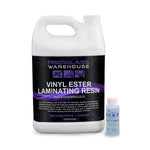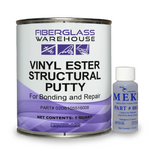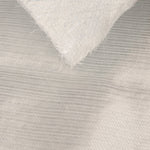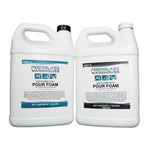You have no items in your shopping cart.
Are you working on a project that requires finding the perfect material for flotation, insulation, soundproofing or void filling? Our Polyurethane Pour Foam is great for hobbyists and do-it-yourselfers who are looking to maximize performance while minimizing cost. This pour foam adheres to most surface types and can be cut and shaped with ease. But before diving head first into your project, let us answer some of the most frequently asked questions about our Polyurethane Pour Foam!
What is polyurethane pour foam and what are its’ uses?
Polyurethane pour foam is a two-part system consisting of an A side and a B side that when mixed together chemically reacts to create an expanding foam. Our closed-cell pour foam has a 1:1 mix ratio. It is U.S. Coast Guard approved for marine use and is great for use in dock floats and boat parts. Once it is cured, the foam prevents moisture and absorption and will not be affected by solvents, oil or gas. It does not contain any CFC blowing agent or other ozone depleting chemicals. It is meant to be poured, not sprayed. We carry 2lb. and 6 lb. densities.
It is often used for flotation, insulation, soundproofing and filling gaps and voids. The number one use for our pour foam is in the marine industry. Many people use it for under their boat decks.
How does pour foam work and what are the benefits of using it?
Pour foam works by reacting chemically when the A side and B side are combined in equal parts. As soon as the two components come into contact with each other they begin to expand rapidly from liquid to solid form. This creates an airtight seal that won’t shrink over time. It protects against potential holes, gaps or cracks where water or air may get in. It resists any water absorption.
What is the difference between your 2lb and 6lb foam densities?
2lb density polyurethane pour foam has a closed cell structure that provides more thermal resistance than open cell foams such as Low-Density spray foam. It provides excellent buoyancy and water resistance. 6lb. density polyurethane pour foam is also closed cell and has a higher density than 2lb foam. It provides better soundproofing properties due to its thicker cell structure. The higher the density of the foam, the greater its strength and insulating properties will be.
What will you need to apply pour foam?
You will need mixing buckets/cups for mixing the two components together. Use an electric drill with a mixing paddle for blending together quickly. The faster/harder you mix the 2 part together, the better it will foam. You only have approximately 45 seconds for mixing before it starts to foam. Once the foam begins to look cloudy, it should be poured immediately.
**Troubleshooting - If the mixture is stirred too slowly, it may cause the foam to overheat and create large bubbles. This is counter-intuitive, but our foam needs a fast stir to create the correct consistency.**
You will also need protective clothing such as an old long sleeve shirt, apron, gloves and safety glasses. Also, a respirator if you are pouring large amounts at one time. You can use a tarp or drop cloth on areas around your work area in case of drips.
It is important to note that if you are working in a closed cavity or a mold, it is necessary to have some small holes for venting. This pour foam will exert some pressure as it expands. If you add more pour foam than there is space for, it will put too much pressure on the surrounding area. Overflow vents can be made by drilling some holes before mixing the foam.
How much volume does a kit create?
2lb Pour Foam
2-pint kit- 1 cubic foot
2- quart kit- 2 cubic feet
2-gallon kit- 8 cubic feet
10-gallon kit- 40 cubic feet
6lb Pour Foam
2-pint kit- .33 cubic feet
2- quart kit- .66 cubic feet
2-gallon kit- 2.67 cubic feet
10-gallon kit- 13.33 cubic feet
This is assuming you are working in temperatures between 75-80 degrees Fahrenheit. As shown above, the 6lb pour foam is a higher density and will not produce as many cubic feet as a 2lb pour foam.
Can I work in colder temperatures than 75-80 degrees Fahrenheit?
It is not recommended. If you work in temperatures below 75-80 degrees, your pour foam will not expand fully. It is important that you work in a warm, well-ventilated area for optimal results. Your surface, the pour foam itself and the room temperature should all be warmed up to 75-80 degrees Fahrenheit.
Can I pour all at once or should I do it in batches?
It is generally best practice to do multiple batches instead of trying to do everything at once. Wait about 15 minutes between pours to make sure you get the best adhesion. Quart batches would be an ideal amount to start with until you have a good handle on how the pour foam works.
What surfaces will pour foam not adhere to?
Pour foam will adhere to most things unless there is mold release, silicone, or oils used to keep it from bonding. You could use a mold release such as Partall #2 if you are working with a mold and need the pour foam to release.
Can I use resin over the pour foam?
Yes, once the foam has fully cured, you can cut or sand it down as well as coat it with polyester, vinyl ester or epoxy resin.
How do I clean up after using pour foam?
You can use denatured alcohol or acetone to clean up any pour foam that has not dried. Once it is dry, it is virtually impossible to remove. Use a tarp or drop cloth below your work area if needed. Protect everything you do not want the pour foam on especially your skin and clothing.
Conclusion
Polyurethane pour foam is an excellent choice for superior flotation, insulation, soundproofing and for filling gaps and voids. It is economical and long lasting. As long as you are prepared, it can be easy to apply.
Still have questions about our pour foam? You can contact our support team for more information at sales@fiberglasswarehouse.com or 1-833-669-7899. We would be happy to help.
To see a quick video of our Two Part Polyurethane Boat Pour Foam in action, click HERE.









